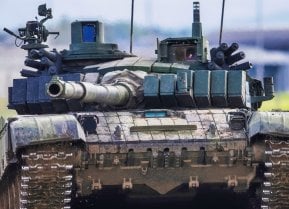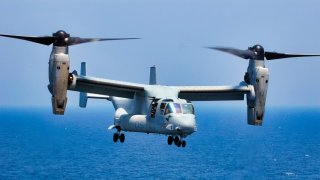The V-22 Osprey Is the U.S. Military's Problem Child Helicopter
The V-22 Osprey, a unique tiltrotor aircraft of the U.S. military, combines the vertical takeoff and landing capabilities of a helicopter with the speed and range of a jet. It serves as a primary air assault platform for the U.S. Marine Corps and supports special operations globally.
Summary: The V-22 Osprey, a unique tiltrotor aircraft of the U.S. military, combines the vertical takeoff and landing capabilities of a helicopter with the speed and range of a jet. It serves as a primary air assault platform for the U.S. Marine Corps and supports special operations globally.
-Capable of carrying 32 troops or 10,000 lbs of cargo, the V-22 Osprey has significant transport capabilities and is armed with defensive weapons like .50 caliber heavy machine guns and 7.62mm miniguns. Despite its operational success and over 600,000 flight hours since 2009, the Osprey has a troubled history, with 50 servicemembers lost in accidents.
-Plans are underway to replace it with the Bell V-280 Valor due to ongoing maintenance challenges, particularly with its engine nacelles.
The V-22 Osprey: A Revolutionary Aircraft with a Complex Legacy
The V-22 Osprey has a unique profile among the U.S. military’s roster of aircraft. A tiltrotor aircraft, the different versions of the Osprey can take off and land like a helicopter but fly like a jet.
This rare capability makes the V-22 ideal for carrying large numbers of troops on the battlefield. The Osprey is the U.S. Marine Corps’ main air assault platform, and it also serves with the Air Force Special Operations Command, supporting American special operators around the world.
The V-22 Osprey: A Unique Aircraft
The tiltrotor aircraft comes with a combat radius of approximately 500 nautical miles, or 575 miles.
It can operate up to 25,000 feet and reach maximum speeds of 280 knots, or about 320 miles per hour. In terms of capacity, the V-22 Osprey can carry 32 troops seated on the floor, 24 troops seated in seats, or 10,000 lbs of cargo.
This lift capacity is important – the Osprey can put almost an entire Army platoon on the ground when needed. In other missions, it can carry almost three Army Special Forces A-Teams, or about two Navy SEAL platoons.
Beyond its transport capabilities, the V-22 can definitely defend itself when needed. The aircraft packs several heavy and light machine guns, including M2 Browning .50 caliber heavy machine guns, GAU-17 7.62mm miniguns, and M240 7.62mm light machine guns. The GAU-17 is part of a self-defense system Bell Boeing installed on the belly of the aircraft that can take out threats when the aircraft lands and takes off—the two most vulnerable points of its missions.
The U.S. military has around 400 Ospreys in service with the Marine Corps, Navy, and Air Force. These aircraft have clocked more than 600,000 operational hours since 2009.
A Unique Aircraft With a Troubled History
Although the unique aircraft brings important capabilities to the table, it has a troubled past.
Since the V-22 entered the production phase in the early 1990s, 50 servicemembers have been killed in a series of deadly accidents. Despite the military’s decades of experience operating the aircraft, accidents keep happening. In the past two years alone, 20 servicemembers have been killed in four accidents.
The Pentagon has had to ground the aircraft for several weeks or months following each mishap, adversely affecting operational capabilities and putting stress on the platforms that have to pick up the slack.
The V-22’s nacelle, an outer casing on the engine that enables the V-22 to take off and land like a helicopter, has been an area of constant trouble for Air Force, Navy, and Marine Corps maintainers.
The Pentagon plans to replace the V-22 Osprey with the Bell V-280 Valor. But that aircraft is still some years out. Until then, the problematic Osprey will have to remain operational, with everyone hoping that its unfortunate streak of mishaps will stop.
About the Author:
Stavros Atlamazoglou is a seasoned defense journalist specializing in special operations and a Hellenic Army veteran (national service with the 575th Marine Battalion and Army HQ). He holds a BA from the Johns Hopkins University and an MA from the Johns Hopkins’ School of Advanced International Studies (SAIS). His work has been featured in Business Insider, Sandboxx, and SOFREP.


